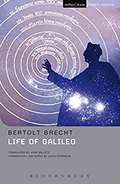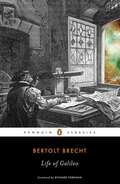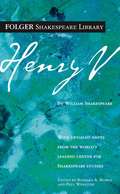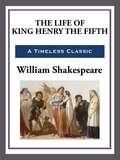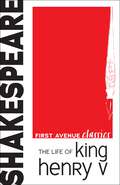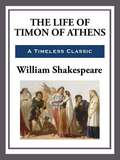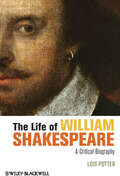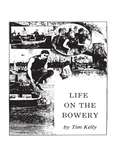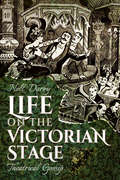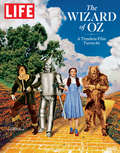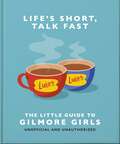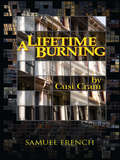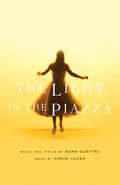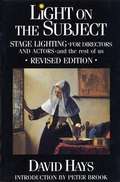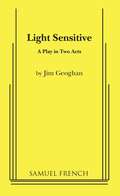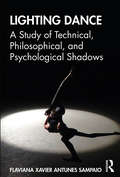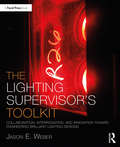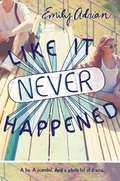- Table View
- List View
The Life of Galileo (Methuen Student Editions)
by Bertolt Brecht Hugh Rorrison John Willett Chris Megson Jenny StevensThis Student Edition of Brecht's classic dramatisation of the conflict between free enquiry and official ideology features an extensive introduction and commentary that includes a plot summary, discussion of the context, themes, characters, style and language as well as questions for further study and notes on words and phrases in the text. It is the perfect edition for students of theatre and literature Along with Mother Courage, the character of Galileo is one of Brecht's greatest creations, immensely live, human and complex. Unable to resist his appetite for scientific investigation, Galileo's heretical discoveries about the solar system bring him to the attention of the Inquisition. He is scared into publicly abjuring his theories but, despite his self-contempt, goes on working in private, eventually helping to smuggle his writings out of the country.
Life of Galileo (Penguin Classics)
by Bertolt Brecht John Willett Ralph ManheimGalileo ranks alongside Mother Courage and Mr. Puntila as one of Brecht's most intensely alive, human, and complex characters. In Life of Galileo, the great Renaissance scientist is in a brutal struggle for freedom from authoritarian dogma. Unable to satisfy his appetite for scientific investigation, he comes into conflict with the Inquisition and must publicly renounce his theories, though in private he goes on working on his revolutionary ideas.
The Life of Henry V (Folger Shakespeare Library)
by William Shakespeare Barbara A. Mowat Paul WerstineA modern interpretation of Shakespeare's war play, this includes explanatory notes before each scene designed to help make Shakespeare's language clearer to a modern reader, and notes are placed on the page facing the text that they explain.
The Life of King Henry the Fifth
by William ShakespeareHenry V is a history play by William Shakespeare, believed to have been written in approximately 1599. It tells the story of King Henry V of England, focusing on events immediately before and after the Battle of Agincourt (1415) during the Hundred Years' War. In the First Quarto text, it was entitled The Cronicle History of Henry the fift, which became The Life of Henry the Fifth in the First Folio text.
The Life of King Henry V (First Avenue Classics ™)
by William ShakespeareIn the wake of his father's death, Prince Henry has ascended to the throne as King Henry V. The rebels have finally been overthrown and the civil war has ended. Henry continues to distance himself from the disreputable friends of his youth in an effort to gain the respect of his subjects. After a dispute with the French over territory, Henry decides to invade France. The English fight their way across the country in a bloody series of conflicts that culminates in the legendary Battle of Agincourt. Will Henry be able to inspire the vastly outnumbered English soldiers on to victory against the French? First published in 1600, this unabridged version of William Shakespeare's history play is the fourth and final in his tetralogy about the rise of the English royal House of Lancaster.
The Life of Monsieur de Molière: A Portrait by Mikhail Bulgakov
by Mirra Ginsburg Mikhail Afanasevich BulgakovThis portrait of Moliere, by Mikhail Bulgakov, goes far beyond mere biography. The Russian master brings a kindred spirit vividly to life in this novelistic story of art and the struggle it demands. Mikhail Bulgakov’s The Life of Monsieur de Moliere is a fascinating portrait of the great French seventeenth-century satirist by one of the great Russian satirists of our own century. For Bulgakov, Moliere was an alter ego whose destiny seemed to parallel his own. As Bulgakov’s translator, Mirra Ginsburg, informs us: "There is much besides their craft that links these two men across the centuries. Both had a sharp satirical eye and an infinite capacity for capturing the absurd and the comic, the mean and the grotesque: both had to live and write under autocracies: both were fearless and uncompromising in speaking of what they saw, evoking storms with each new work: and shared what Bulgakov calls ’the incurable disease of passion for the theater.’ The life of Moliere, born Jean-Baptiste Poquelin, is a story of struggle and dedication, and Bulgakov tells it with warmth and compassion. Indeed, for all Bulgakov’s careful attention to historical detail, his vivid recreation of seventeenth-century France makes The Life of Monsieur de Moliereread more like a novel than a formal biography. Mikhail Bulgakov (1891-1949) is best known in the West for his monumental novel The Master and Margarita. His The Life of Monsieur de Moliere, completed in 1933, was not published until 1962. Mirra Ginsburg’s translation of this neglected masterpiece will find a welcome readership among devotees of the theater and of modern Russian literature.
The Life of the Author: William Shakespeare (The Life of the Author)
by Anna BeerDiscover an invigorating new perspective on the life and work of William Shakespeare The Life of the Author: William Shakespeare delivers a fresh and exciting new take on the life of William Shakespeare, offering readers a biography that brings to the foreground his working life as a poet, playwright, and actor. It also explores the nature of his relationships with his friends, colleagues, and family, and asks important questions about the stories we tell about Shakespeare based on the evidence we actually have about the man himself. The book is written using scholarly citations and references, but with an approachable style suitable for readers with little or no background knowledge of Shakespeare or the era in which he lived. The Life of the Author: William Shakespeare asks provocative questions about the playwright-poet’s preoccupation with gender roles and sexuality, and explores why it is so challenging to ascertain his political and religious allegiances. Conservative or radical? Misogynist or proto-feminist? A lover of men or women or both? Patriot or xenophobe? This introduction to Shakespeare’s life and works offers no simple answers, but recognizes a man intensely responsive to the world around him, a playwright willing and able to collaborate with others and able to collaborate with others, and, of course, his exceptional, perhaps unique, contribution to literature in English. The book covers the entirety of William Shakespeare’s life (1564-1616), taking him from his childhood in Stratford-upon-Avon to his success in the theatre world of London and then back to his home town and comfortable retirement. The Life of the Author: William Shakespeare sets his achievement as a writer within the dangerous, vibrant cultural world that was Elizabethan and Jacobean England, revealing a writer’s life of frequent collaboration, occasional crisis, but always of profound creativity. Perfect for undergraduate students in Literature, Drama, Theatre Studies, History, and Cultural Studies courses, The Life of the Author: William Shakespeare will also earn a place in the libraries of students interested in Gender Studies and Creative Writing.
Life Of the Party
by Marrijane HayesComedy / 7m, 10f / Interior / The Hughes family moves to Butterfield and begins to choose friends. Mr. Hughes is there on business. Mrs. Hughes has social ambitions. Oldest daughter Mildred fancies herself in love with the snooty son of a bank president. Studious daughter Jean flings off her glasses and becomes the life of the party. Dapper Teddy gets into a merry mix up juggling four dates at once. And daughter Amy falls in love for the first time. But the whole family is in for a hard awakening. They all become aware of the serious implications of what had seemed very funny and make wise readjustments to one another and to life.
The Life of Timon of Athens
by William ShakespeareTimon of Athens is a bitterly intriguing study of a fabulously rich man who wastes his wealth on his friends, and, when he is finally impoverished, learns to despise humanity with a hatred that drives him to his grave. The play's plot structure is schematically clear, and the poetry of Timon's rage is arresting in its savage intensity. Yet readers have often detected loose ends, and the tone of writing is uneven.
The Life of William Shakespeare
by Lois PotterThe Life of William Shakespeare is a fascinating and wide-ranging exploration of Shakespeare's life and works focusing on oftern neglected literary and historical contexts: what Shakespeare read, who he worked with as an author and an actor, and how these various collaborations may have affected his writing. Written by an eminent Shakespearean scholar and experienced theatre reviewer Pays particular attention to Shakespeare's theatrical contemporaries and the ways in which they influenced his writing Offers an intriguing account of the life and work of the great poet-dramatist structured around the idea of memory Explores often neglected literary and historical contexts that illuminate Shakespeare's life and works
Life on the Bowery of the Liar's Doom
by Tim KellyComic melodrama / 8m, 10f, optional extras / Simple staging / Based on Robert Neilson Stephens' On the Bowery, this stage success depicts wild and wicked deeds. This version is easy to rehearse and produce, but misses none of the fun and thrills. Mrs. Drayton wishes her daughter Alice to marry villainous Thurlow Bleekman but she loves reporter Jack Hobart. The Drayton mansion is robbed and Bleekman blames Jack, forcing him to prowl the Bowery dressed as a Chinese waiter amid the riff raf who congregate at Brody's. Meanwhile, Bleekman's girlfriend threatens to reveal his true character if he does not marry her. In the play's funniest scene the villain engages burglars to toss the troublesome girl from the Brooklyn Bridge. The villain meets his liar's doom, Jack and Alice marry, and a lost daughter and mother are reunited while the laughter rolls on. Optional olio acts can add to the hilarity. "Entertaining ... theatre rocked with good natured laughter" Hollywood Ledger .
Life on the Victorian Stage: Theatrical Gossip
by Nell DarbyThe expansion of the press in Victorian Britain meant more pages to be filled, and more stories to be found. Life on the Victorian Stage: Theatrical Gossip looks at how the everyday lives of Victorian performers and managers were used for such a purpose, with the British newspapers covering the good, the bad and the ugly side of life on the stage during the nineteenth century. Viewed through the prism of Victorian newspapers, and in particular through their gossip columns, this book looks at the perils facing actors from financial disasters or insecurity to stalking, from libel cases to criminal trials and offers an alternative view of the Victorian theatrical profession.This thoroughly researched and entertaining study looks at how the Victorian press covered the theatrical profession and, in particular, how it covered the misfortunes actors faced. It shows how the development of gossip columns and papers specializing in theater coverage enabled fans to gain an insight into their favorite performers lives that broke down the public-private divide of the stage and helped to create a very modern celebrity culture.The book looks at how technological developments enabled the press to expose the behavior of actors overseas, such as when actor Fred Solomon's' bigamy in America was revealed. It looks at the pressures facing actors, which could lead to suicide, and the impact of the 1857 Matrimonial Causes Act on what the newspapers covered, with theatrical divorce cases coming to form a significant part of their coverage in the latter half of the nineteenth century. Other major events, from theater disasters to the murder of actor William Terriss, are explored within the context of press reportage and its impact. The lives of those in the theatrical profession are put into their wider social context to explore how they lived, and how they were perceived by press and public in Victorian Britain.
LIFE The Wizard of Oz
by The Editors of LIFEThe editors of LIFE Magazine present LIFE The Wizard of Oz.
Life's Short, Talk Fast: The Little Guide to Gilmore Girls
by Orange Hippo!Almost 25 years have passed since Gilmore Girls first hit our TV screens, but the iconic show continues to captivate audiences with its warmth, humor, and irresistible storytelling. Celebrated for its loveable cast of characters and relatable moments, the series has explored the complexities of family, friendship and the pursuit of dreams and has been described as one of the greatest television shows of all time.This pocket-sized companion will transport readers into the whimsical world of mum-and-daughter duo Lorelai and Rory, and the beloved residents of Stars Hollow - a place where the coffee flows endlessly and witty banter is a way of life. From Lorelai's lightning-fast comebacks to Rory's insightful musings, the pages are crammed with the delightful dialogue and memorable lines that made the Gilmore Girls series so cherished, while behind-the-scenes stories and fascinating tidbits will satisfy even the most devoted fan. "Oy with the poodles already!" Lorelai's exclamation in the first episode, expressing her frustration, became an iconic line."I can't stop eating. I eat because I'm unhappy, and I'm unhappy because I eat. It's a vicious cycle." A classic Lorelai moment, highlighting her humour and love for food."A cheeseburger, onion rings, and a list of people who killed their parents and got away with it. I'm looking for heroes." The unforgettable line when Lorelai storms into the diner and shouts her order."Trig, I can do. But boys and dating, forget it."Rory reflecting on her love life.
Life's Short, Talk Fast: The Little Guide to Gilmore Girls
by Orange Hippo!Almost 25 years have passed since Gilmore Girls first hit our TV screens, but the iconic show continues to captivate audiences with its warmth, humor, and irresistible storytelling. Celebrated for its loveable cast of characters and relatable moments, the series has explored the complexities of family, friendship and the pursuit of dreams and has been described as one of the greatest television shows of all time.This pocket-sized companion will transport readers into the whimsical world of mum-and-daughter duo Lorelai and Rory, and the beloved residents of Stars Hollow - a place where the coffee flows endlessly and witty banter is a way of life. From Lorelai's lightning-fast comebacks to Rory's insightful musings, the pages are crammed with the delightful dialogue and memorable lines that made the Gilmore Girls series so cherished, while behind-the-scenes stories and fascinating tidbits will satisfy even the most devoted fan. "Oy with the poodles already!" Lorelai's exclamation in the first episode, expressing her frustration, became an iconic line."I can't stop eating. I eat because I'm unhappy, and I'm unhappy because I eat. It's a vicious cycle." A classic Lorelai moment, highlighting her humour and love for food."A cheeseburger, onion rings, and a list of people who killed their parents and got away with it. I'm looking for heroes." The unforgettable line when Lorelai storms into the diner and shouts her order."Trig, I can do. But boys and dating, forget it."Rory reflecting on her love life.
A Lifetime Burning
by Cusi CramCharacters: 3 female, 1 maleIf you had the power to revise your past, what would you change? Who would you be? Trust fund darling Emma imagines what her life would have been like had she come from a less privileged background. Trouble is, she chronicles her alternate life in a new tell-all "memoir" that was sold for a hefty advance. When Emma is exposed, will her sister, Tess, stand by her? Or will Emma's deceit destroy their already fractured relationship? This dark comedy brings up questions of legacy, loyalty and what it means to belong."The dialogue crackles with snappy sarcasms." -The New York Times "A terrific indictment of the reality-obsessed culture in which we live." - Theatermania.com"Quirky, often funny, and sometimes surprisingly sharp-witted writing." -The Village Voice
The Light in the Piazza
by Craig Lucas Adam Guettel"The Light in the Piazza beautifully captures the eternal allure of Italy. . . . The story wraps itself around your heart."--Chicago Sun-Times"Guettel's music and lyrics take nothing from the razzle-dazzle bargain basement of feeling; they represent, instead, a genuine expense of spirit. . . . The Light in the Piazza doesn't want to make theatre-goers feel good; it wants to make them feel deeply."--The New Yorker"With Adam Guettel's gorgeous melodies, a compelling narrative hook from Craig Lucas, and moving themes about happiness and risk, there's no question that The Light in the Piazza is Broadway worthy."--Daily VarietyComposer Adam Guettel, best known for his Floyd Collins, has teamed with Prelude to a Kiss playwright Craig Lucas to create a passionate and soaring new musical based on Elizabeth Spencer's 1960 novella, which was first published as an entire issue of The New Yorker. It is the story of an American ingénue abroad, whose chance meeting of a charming young Italian in a Florentine piazza sets off a whirlwind romance--with an unsettling revelation. The Light in the Piazza opens on Broadway at the Lincoln Center Theater this spring after major productions already in Seattle and Chicago.Adam Guettel wrote music and lyrics for Floyd Collins, produced across the country and in London. His other works include Love's Fire, a collaboration with John Guare, and Saturn Returns, a concert at The Public Theater/New York Shakespeare Festival that was recorded by Nonesuch Records under the title Myths and Hymns.Craig Lucas won this year's Obie Award for Best American Play for Small Tragedy and the New York Film Critics Award for Best Screenplay for The Secret Lives of Dentists. His other plays include Reckless, Blue Window, Prelude to a Kiss, God's Heart, The Dying Gaul, Missing Persons, Stranger, and Singing Forest.
Light On The Subject: Stage Lighting For Directors And Actors - And The Rest Of Us
by David HaysThe aim of this book is to demystify the technology of stage lighting, and it does so by uniting its text with quotations from literature, thus setting a common ground for the perception and understanding of light, in our daily lives as well as on stage.
Light Sensitive
by Jim GeoghanDramatic Comedy. . Characters: 2 male, 1 female. Interior Set. Thomas Hanratty, lifelong resident of Hell's Kitchen and once the most dangerous white cab driver in New York, was blinded eight years ago in a drunken accident and is fading into a routine of self pity and alcohol. His bartender and only friend, who was partly responsible for the accident, is moving to Vermont with a new lady friend, but he can't abandon Tom. He recruits an unattractive, slightly handicapped volunteer reader from the Lighthouse who battles her way through Tom's shell. By the second act, they are falling in love. His buddy returns with tales of his "Christmas from hell" in Vermont, and doubt arises as to who will hold the number one position in Tom's life. . "Geoghan brings his characters to life and the audience to its feet cheering." -The Los Angeles Times
Lighting Dance: A Study of Technical, Philosophical, and Psychological Shadows
by Flaviana Xavier SampaioLighting Dance pioneers the discussion of the ability of lighting design to foreground shadow in dance performances. Through a series of experiments integrating light, shadow, and improvised dance movement, it highlights and analyses what it advances as an innovative expression of shadow in dance as an alternative to more conventional approaches to lighting design. Different art forms, such as painting, film, and dance pieces from Loie Fuller, the Russell Maliphant Dance Company, Elevenplay, Pilobolus, and the Tao Dance Theater served to inspire and contextualise the study. From lighting to psychology, from reviews to academic books, shadows are examined as a symbolic and manipulative entity. The book also presents the dance solo Sombreiro, which was created to echo the experiments with light, shadow, and movement aligned to an interpretation of cultural shadow (Jung 1954, in Samuels, Shorter, and Plaut 1986; Casement 2006; Ramos 2004; Stein 2004; and others). The historical development of lighting within dance practices is also outlined, providing a valuable resource for lighting designers, dance practitioners, and theatre goers interested in the visuality of dance performances.
Lighting Design Beyond Theatre: A Process for the Evolving Entertainment Industry
by Allen Branton Sharon HuizingaLighting Design Beyond Theatre provides a step-by-step design process for live event lighting outside of traditional theatre, dance, and opera, including concerts and tours, awards shows, sporting events, benefits, comedy shows, corporate events, fashion shows, political events, and more.This book introduces the origins and history of live events, establishes a shared practice for lighting designers working in live event design, compares and contrasts where lighting design process for theatre, dance, and opera differs from lighting design process for live events, and provides practical considerations and wisdom about navigating the work culture of these events. Containing case studies and exercises, the book outlines holistic processes and practices for this career, including building a task list, choosing equipment, incorporating constructive feedback, leadership, the realities of money and client relations, and getting invited back for more job opportunities.This book is written for students of lighting design and emerging lighting designers interested in exploring lighting design outside the traditional theatre industry, as well as instructors teaching lighting design for nontheatrical live events.Lighting Design Beyond Theatre includes access to downloadable materials for instructors and readers to use as a project, following along with the exercises in the book. These materials represent the information available at various steps in a design process for a realized show, from venue and site information to scenic renderings and schedule details. The final light plot and production photos are also included.
The Lighting Supervisor's Toolkit: Collaboration, Interrogation, and Innovation toward Engineering Brilliant Lighting Designs (The Focal Press Toolkit Series)
by Jason E. WeberThe Lighting Supervisor’s Toolkit guides readers through the Lighting Supervisor’s production process with an emphasis on the importance of the collaborative nature of the role. Lifting the veil on a process regularly learned on the job, this book offers a deeper understanding of the role of Lighting Supervisor and how to take lighting designs from dreams to reality. Readers will learn to communicate with designers, analyze drawings, plan installations, document decisions, supervise crews, and innovate out-of-the-box solutions. Providing guidance for technically focused individuals seeking deeper understanding of the profession, The Lighting Supervisor’s Toolkit is ideal for students and professional technicians looking to take on important leadership roles in theatrical and entertainment lighting.
Lighting Technology: A Guide For The Entertainment Industry
by Brian Fitt Joe ThornleyAnyone working with lighting in the entertainment industries will find this an immensely readable source of information. The authors, themselves experienced lighting practitioners, have collected a wealth of essential lighting technology and data into one comprehensive reference volume in an accessible, jargon-free style. The new edition of this popular text covers the very latest technology, including advances in lamps, motorised lights, dimmers and control systems and current safety regulations.
Like It Never Happened
by Emily AdrianStereotypes, sexuality, and destructive rumors collide in this smart YA novel for fans of Sara Zarr's Story of a Girl, Siobhan Vivian's The List, and E. Lockhart's The Disreputable History of Frankie Landau-Banks.When Rebecca Rivers lands the lead in her school's production of The Crucible, she gets to change roles in real life, too. She casts off her old reputation, grows close with her four rowdy cast-mates, and kisses the extremely handsome Charlie Lamb onstage. Even Mr. McFadden, the play's critical director, can find no fault with Rebecca.Though "The Essential Five" vow never to date each other, Rebecca can't help her feelings for Charlie, leaving her both conflicted and lovestruck. But the on and off-stage drama of the cast is eclipsed by a life-altering accusation that threatens to destroy everything...even if some of it is just make believe.
